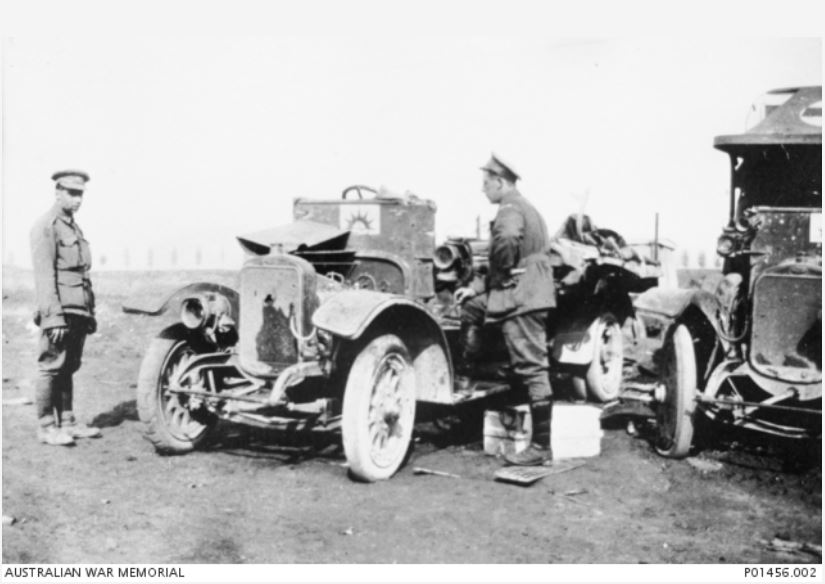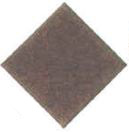Difference between revisions of "5th Field Ambulance"
From Our Contribution
(→Patients) |
|||
| Line 58: | Line 58: | ||
* [[John Henry Holroyd]] 27 - 30 Mar 1917 | * [[John Henry Holroyd]] 27 - 30 Mar 1917 | ||
* † [[William Hall]] 30 Apr 1917 & 1 Jun 1917 | * † [[William Hall]] 30 Apr 1917 & 1 Jun 1917 | ||
| + | * † [[Gilbert Henry Balinswella]] 3 May 1917 | ||
* [[Ernest Henry Chisholm]] 3 May 1917 | * [[Ernest Henry Chisholm]] 3 May 1917 | ||
* [[Frederick Hobbs]] 3 May 1917 | * [[Frederick Hobbs]] 3 May 1917 | ||
Latest revision as of 20:46, 26 August 2023
 Two Ambulances of 5th Field Ambulance show damage caused by high explosives AWM P01456.002 | |
 Shoulder patch | |
Brief History
The Unit was raised at Liverpool (Sydney) camp on the 15th Mar 1915. The Unit then moved to Queens Park, Waverley where all branches of training was carried out. On the 12 May 1915, one Officer and thirteen other ranks left for EGYPT on board HMAT A32 Themistocles. The Ambulance Transport Sub Divisions and part of C section departed Sydney on the 31 May 1915 on board HMAT A31 Ajana, and the main body of the Field Ambulance departed on the 25 Jun 1915 on board HMAT A40 Ceramic. A mishap occurred with the Ajanain that due to the extreme heat in the Red Sea, the ship berthed at Bombay to give the horses a spell, but on entering the docks it struck the lock gate and buckled her bow. This gave the all the troops aboard a week in Bombay whilst repairs were carried out.
Disembarking in Suez, the troops were railed to Heliopolis, where they went into camp. Following training and equipping, the field ambulance departed for Gallipoli (minus its transport element) and arrived at Anzac Cove, before daylight, on the 22 Aug 1915. Eight Officers and 198 Other Ranks disembarked in the early hours of the morning with the last party reaching the shore just after daybreak. For the remainder of the day, the unit rested in Reserve Gully. At 7.30pm, it left for Hills Point and their first task was for the stretcher bearers who were called on to assist in carrying wounded from Hill 60. On the following day, the Field Ambulance set up its first Dressing Station by establishing an Aid Post at Waldrons Point, the first ambulance post to be set up by an Australian Division. Overnight they processed 307 casualties through the Aid Post. This consisted of a small operating tent where 6 Medical Officers and staff were working continuously. The stretcher-bearers had to carry patients approx. 5 kilometers and the unit suffered its first casualty when Pte. W. Ramage was killed while collecting wounded in no mans land. On 7 Sep 1915, B section moved to Popes Post while A and C sections went to Rest Gully. Later, B section moved to Mule Gully. While some volunteers remained to the last to treat injured men, the majority of the unit left Gallipoli on 15 Dec 1915. Of teh 2,934 patients treated by the unit, 969 of them later rejoined their units for duty. Christmas was spent on Lemnos., with return to Alexandria on 8 Jan 1916.
Back in Egypt they traveled by train to Tel-el-Kabir, where the transport sub-divisions rejoined before the unit moved to Ferry Post on the Canal. The unit left Moascar for France on 17 Mar 1916 aboard HMT Arcadian and arrived without mishap at Marseilles on the 22nd. The following night the unit left by train for Northern France. The impressions of this 3-days journey will never be forgotten as the troops witnessed smiling faces, waving handkerchiefs and blowing kisses from every farmhouse and village and railway station they passed through. Gifts of flowers and fruit were pressed on them. The destination was a small French village about 25 miles from the front line. In the distance could be seen the flashes from the guns and flares and the reports of the shell explosions would float back to our lines.
On the 1st of July, the unit moved to the SOMME to take part in the attacks on Pozieres. The unit, during that time, was in charge of the evacuation of a Divisional front and all patients passed through their HQ at Becourt Chateau. The unit then moved back to Canaples where recuperation and reorganisation took place. Here a new C section was formed and the unit was brought back to its former strength. On 29 August the unit was back in the line. The battle was still raging and the unit worked with stretcher bearers from other Field Ambulances on a line of evacuation running through the place where Pozieres had once been, out to Mouquet Farm. After a week or so, the unit left for Vardencourt and from there took over part of the line in the Ypres sector. A fairly quiet month was spent there before they were sent back to the SOMME for the winter.
After a rest at Ribemont, our HQ took over the post in the German-made dug-outs under the remains of the famous Contalmaison Chateau. their Advanced Dressing Station was at Martinpuich. A number of stretcher squads from our unit formed part of the column pursuing the Germans who withdrew to the Hindenburg Line, tasked with keeping in close touch with the enemy. Their next engagement was at Bullecourt where the stretcher-bearers of ALL the ambulances engaged earned special praise for their magnificent work under constant observation and enemy shellfire. Unfortunately, more casualties were suffered here than in any previous action. After Bullecourt, the Australian units received a well earned rest and during May, June and July 1917 before returning to the front in time for Passchendaele.
under construction
Forty two men lost their lives while posted to this unit. The unit was disbanded in England in 1919
Patients
1916
- Charles Glyn Firns 12 - 13 Oct 1916
- Charles Richard Irvine MM & Bar 14 Oct 1916
- Edward Briggs 4 & 5 Nov 1916
- Lionel William Gibbs 5 Nov 1916
- Charles Gorringe 5 Nov 1916
- Patrick Michael 5 Nov 1916
- † Arthur William Griffin 11 - 17 Nov 1916
- † Maurice Clarence Robinson 17 - 20 Nov 1916
- John Edward Thomson 21 Nov - 11 Dec 1916
- John Henry Wilkinson 26 Nov 1916
- Mount (Mont) Alexander Taylor 2 - 10 Dec 1916
- William Plant 6 Dec 1916
- Ernest James Brandon Bettenay 23 Dec 1916
- John (Senior) Shepherd 28 Dec 1916
1917
- † Frederick William Vernon King 4 Jan 1917
- James Anthony Parker 4 - 16 Jan 1917
- John Grant Watt MM & Bar 7 Jan 1917
- Reginald Grove Sexty MID 20 Mar 1917
- John Henry Holroyd 27 - 30 Mar 1917
- † William Hall 30 Apr 1917 & 1 Jun 1917
- † Gilbert Henry Balinswella 3 May 1917
- Ernest Henry Chisholm 3 May 1917
- Frederick Hobbs 3 May 1917
- † John Hobbs 3 May 1917
- Ernest Alfred (Jack) Lewis 4 May - 17 Jun 1917
- Thomas Kinsman Bickell 5 or 6 May 1917
- Robert Lightbody 6 May 1917
- Sylvanus Benjamin Buckland 6 - 11 May 1917
- Claude Eustace Herbert Evans 6 May 1917
- Alexander Dowle 5 Jun 1917
- Henry Albert Thorp 7 - 8 Jun 1917
- † David Edward Bromley 9 Jun 1917
- Gordon Edgar (George) Bennett 29 - 30 Jun 1917
1918
- † Gordon Weston Johanson 15 May 1918
- Reginald William Edwards 18 - 19 May 1918 & 5 Oct 1918
- Gordon Edgar (George) Bennett 1 Jun 1918
- † Roland Parker Shelley 3 Jun 1918
- Leo Patrick Kane 10 Jun 1918
- Henry Ivor Passmore DCM 10 Jun 1918
- Charles Robert Merchant 30 Jun 1918
- Harold Empsall 28 Jul 1918
- Frederick Hobbs 11 Aug 1918
- Bertram Ernest Powell 11 - 12 Aug 1918
- † Daniel Malcolm Wann 13 Aug 1918
- Roby Halliwell 2 - 3 Sep 1918
- Macalister Adair Blain 3 Sep 1918
- Walter Hayward 3 Sep 1918
1919
- Harold Empsall 11 Mar 1919
Individual Honours
- 3 x Distinguished Service Order
- 1 x Distinguished Conduct Medal
- 44 x Military Medal
- 4 x Bar to Military Medal
- 7 x Meritorious Service Medal
- 10 x Mentioned in Despatches
- 3 x Belgium Croix de Guerre
- 1 x French Medaille des Epidemies, Silver
Notes